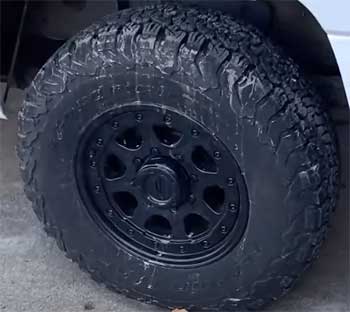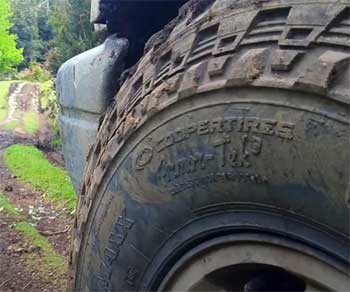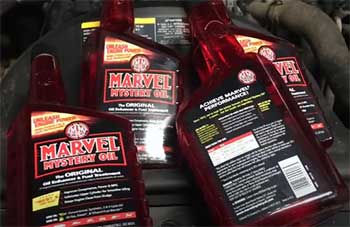The selection of suitable tires for your vehicle is critical, ensuring your safety on the road and a smooth ride. In this article, we will be deciphering the jargon in the tire world, specifically looking at C rated and E rated tires.
In this comprehensive guide, you’ll find detailed explanations of these ratings, their differences, and key advantages and disadvantages.
A Comprehensive Comparison Table
| Feature | C Rated Tires | E Rated Tires |
| Construction | 6-ply | 10-ply |
| Load Bearing Capacity | Up to 2,000 lbs per tire | Over 3,000 lbs per tire |
| Ride Comfort | More comfortable ride, absorbs road imperfections better | Stiffer ride, may feel road imperfections more |
| Fuel Efficiency | Lower rolling resistance, may improve fuel efficiency | Higher rolling resistance, may reduce fuel efficiency |
| Ideal Application | Regular commuting, light-duty use | Heavy-duty use, towing trailers, off-road driving |
What do C and E Ratings Mean on Tires?
The load range or tire ply rating is expressed as letters on tires, including C and E. This rating is directly linked to the tire’s ability to support a particular load at a specific air pressure. Here’s a basic rundown:
- C rated tires (also known as load range C) have a 6-ply rating. They are generally found on light-duty vehicles like passenger cars, SUVs, and small pickup trucks. These tires are designed to handle lighter loads, typically less than 2,000 lbs per tire.
- E rated tires (or load range E) are 10-ply tires, typically used on heavier duty trucks, vans, and larger SUVs designed for hauling heavy loads or towing trailers. Each E rated tire can typically handle loads over 3,000 lbs.
C Rated Tires: Pros and Cons

Pros
C rated tires are designed for regular passenger vehicles, thus offering superior ride comfort and lower rolling resistance, which may result in better fuel efficiency.
These tires tend to have a softer sidewall, allowing for a smoother ride over bumps and potholes.
Cons
The downside? C rated tires are not ideal for heavy loads.
If you frequently haul heavy cargo or tow a trailer, these tires may wear out quicker and possibly fail under the extra strain.
Also Read: Comparison of LT And XL Rated Tires.
E Rated Tires: Pros and Cons
Pros
E rated tires are a champion when it comes to durability and load-bearing capability. They can support heavy-duty vehicles and withstand substantial loads without compromising on safety or performance. These tires are designed for strenuous work and rough conditions.
Cons
The tradeoff? E rated tires might be overkill if you do not frequently carry or tow heavy loads. They tend to provide a stiffer ride, which some drivers find less comfortable. Additionally, these tires can decrease fuel efficiency due to higher rolling resistance.
Key Differences between C Rated and E Rated Tires
When comparing C rated and E rated tires, it’s essential to delve deeper into their primary differences. Let’s break it down feature by feature:
- Construction

One significant difference lies in their construction. C rated tires typically have a 6-ply construction.
The term ‘ply’ refers to the number of layers in the tire’s carcass or body.
The layers can be made from different materials like steel, polyester, or composite.
On the other hand, E rated tires come with a 10-ply construction.
As you might guess, more plies generally mean a stronger tire.
They can handle more load, which makes E rated tires a popular choice for heavy-duty vehicles.
- Load Bearing Capacity
The load rating is a key differentiator between C and E rated tires. A tire’s load rating indicates the maximum weight the tire can safely support when properly inflated.
C rated tires are designed to handle lighter loads, generally less than 2,000 lbs per tire. This makes them suitable for small to medium vehicles, like sedans, hatchbacks, and some SUVs.
E rated tires, with their higher ply rating, can typically support loads over 3,000 lbs. This higher load capacity makes them a better choice for heavier vehicles like large SUVs, vans, and trucks that are used for towing or hauling heavy loads.
- Ride Comfort
The comfort of the ride differs quite a bit between these two types of tires. C rated tires, with fewer plies, have more flexible sidewalls, which absorb road imperfections, providing a smoother and more comfortable ride.
E rated tires, with their extra plies, have stiffer sidewalls. This stiffness can result in a harsher ride as the tire transmits more of the road’s imperfections to the vehicle.
However, this stiffness can be beneficial when carrying or towing heavy loads as it helps to stabilize the vehicle.
- Fuel Efficiency
Tire selection can significantly impact your vehicle’s fuel efficiency. C rated tires tend to offer lower rolling resistance than E rated tires, which can result in better fuel efficiency.
On the flip side, the heavier construction and higher rolling resistance of E rated tires may lead to slightly reduced fuel economy.
- Application
The choice between C rated and E rated tires also depends on the type of driving you do. For city driving or regular commuting, C rated tires would likely serve you well.
However, if your vehicle is used for heavy-duty work, like towing large trailers, or if you often drive off-road, then the robust construction of E rated tires would likely be more beneficial.
Also Read: Comparison of C And XL Rated Tires.
Frequently Asked Questions (FAQ)
The necessity for E rated tires depends on your vehicle usage. If your vehicle regularly hauls heavy loads, tows trailers, or is used off-road, E rated tires are a great choice. However, for regular commuting or light-duty use, a C rated tire should suffice.
In a nutshell, C and E ratings indicate the load-bearing capacity of a tire. C rated tires (6-ply) are suited for lighter loads, while E rated tires (10-ply) are designed for heavier loads.
Wrapping Up
Understanding these load ratings and choosing the right tire for your vehicle’s needs is crucial. It affects your safety, vehicle performance, and overall driving experience.
So, next time you’re in the market for new tires, remember this guide and make an informed decision. Your vehicle (and your wallet) will thank you!

